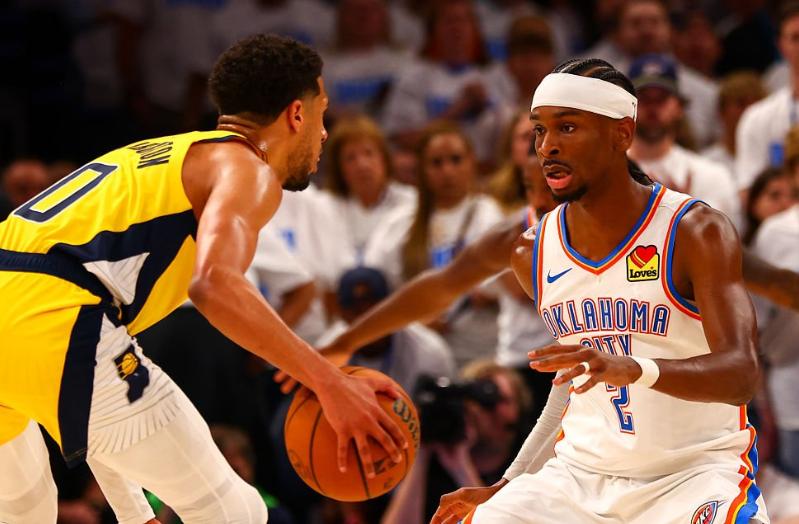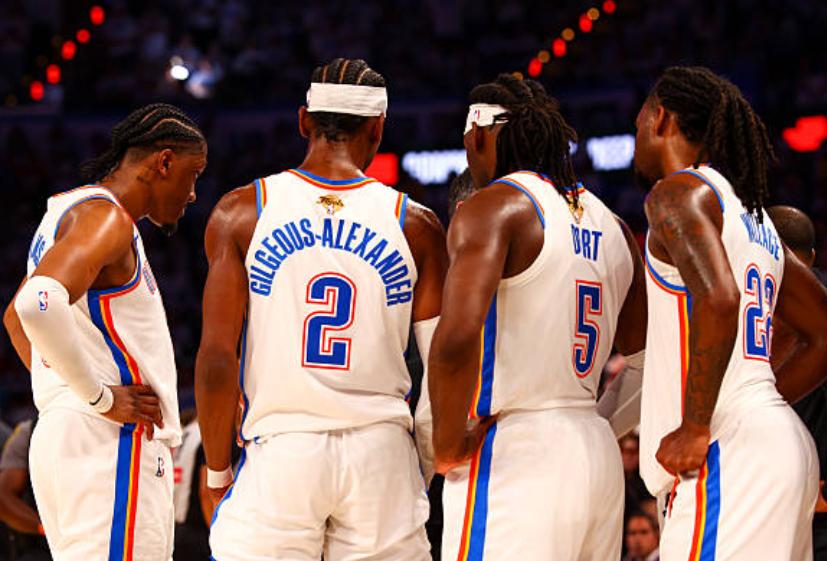The official website lists the four highlights of the finals G2: Thunder or change formation again, Alexander plays more without the ball?
The NBA Finals G2 will start at 8 a.m. Beijing time on June 9, and the current overall score is that the Pacers lead the Thunder 1-0. What kind of plot will be staged in G2 of the finals? The NBA's official website lists four major highlights worth paying attention to in G2 of the Finals -


1. Pay attention to the Thunder's roster adjustments
Center Hartenstein started 53 of his 57 regular-season appearances despite suffering from injuries, and was a starter in each of the 16 playoff games leading up to G1 in the Finals. The Thunder had a 57-12 record when he started. But in the opening game of the Finals, Coach Dagneault opted for a smaller starting lineup, putting guard Carson Wallace in the starting line-up, breaking up the twin towers of Hartenstein and Holmgren. Wallace started in place of Hartenstein with the intention of better coping with the Pacers' fast pace and optimizing the personnel alignment.
The result?
On the positive side: The first half forced the Pacers into 19 turnovers as the Thunder led 57-45.
Negative: The rebound was crushed by the Pacers 56-39.

As one of the Thunder's "Big Three", Holmgren averaged 16.4 points and 8.6 rebounds per game in the first three rounds of the playoffs, but only scored 6 points and 6 rebounds in the first game and played less than 24 minutes. Hartenstein played 17 minutes and contributed nine points and seven rebounds — a decent stat based on his regular 28 minutes of play, but not enough to impact the game in a short period of time.
Key Data Breakdown:
In the regular season and playoffs this season, the Thunder have a record of 37-3 (regular season) + 8-1 (playoffs) when rebounding ≥ opponents; When rebounding is at a disadvantage, the record is only 4-4.
It's worth noting that the Knicks have played highly efficiently against the Pacers when they used the twin tower combination of Mitchell Robinson and Towns.
2. Pacers need to reduce ball control errors
In the first half of the opening game, the Pacers made a whopping 19 turnovers — the first time in nearly 18 years that an NBA team had so many turnovers in the first half of a single game. It's a stylistic opening for the Thunder's "clingy defense," but it's an anomaly for the Pacers, who typically maintain precision on the fast break.

As Haliburton said: "We like 'controlled chaos', but the first half was just chaos, it was ugly. ”
The Pacers showed a response to the Thunder's top defense in the second half (forcing opponents to 17 turnovers per game in the regular season, first in the league) -
Slowing down and precise passing: In the second half, possession was reduced from 54 to 47, and the passing was more purposeful.
Fewer core player turnovers: Big man Obi Toppin as an outside threat had three turnovers in the first five minutes of the first quarter, but zero turnovers in the final 20 minutes.
3. The Pacers' shooting is still the biggest advantage
Although frequent turnovers in the first half reduced offensive rounds, the offensive rounds completed by the Pacers were extremely efficient. With Haliburton's stunner, they narrowed the risk with 111 points, continuing a key pattern:
In the regular season this season, the Pacers had a 45-23 record when scoring ≥ 110 points; So far in the playoffs, he has a 13-0 record when scoring ≥ 110 points. With fewer than 110 points this season, the Pacers are 5-14.

In terms of shooting efficiency:
So far in the playoffs, the Pacers have shot 49.6% overall, 40.5% from three-point range, and 61.2% from the field, ranking first among playoff teams in all three statistics.
In the regular season, the Pacers ranked third, ninth and fifth, respectively, and found a way to create the best shooting space through extra preparation time and repeated study of the opponent's defense.
Takeaway for the Thunder: Perhaps the reliance on "forcing turnovers" should be reduced and instead focused on disrupting the Pacers' shooters and forcing them away from their habitual shots. In the second half of the first game, the Pacers shot 51.1% from the field and 10 of 20 three-pointers, outscoring the Thunder by 13 points at 66-53.
4. The Thunder need to let Alexander play more off the ball
Alexander showed his MVP scoring prowess in his opening game, scoring 38 points on 14-of-30 shooting, but dished out just three assists in 39 minutes of playing time, less than half of his season average of 6.8 assists per game. The Thunder's 39 all-out goals were accompanied by just 13 assists, well below their season average of 26.9 assists per game.

More notably, the Thunder made just 208 passes in a game — the fewest passes in any game this season and the second-fewest passes in a single playoff game since the league began collecting tracking data in 2013-14 (behind only a playoff game between the Cavaliers and the Pacers).
The root of the problem: Relying too much on Alexander's ball-carrying offense allowed the Pacers to target his passing lanes. Teammate Jalen Williams leads the team with six assists (close to his average per game), and he may need to take on more playmaking tasks to enrich his play. The Thunder bench played a total of 71 minutes and provided just two assists, exposing the lack of creativity in the second team.


Wonderfulshortvideo
Bronny James getting things started 👏


Was this the craziest Anthony Edwards dunk ever? 🤯😯


The secret behind Steph's shots


Foot was on the line! 🫠


Team USA was ready for war last summer 👏


Perfect timing 🙌


Last year’s








 Links
Links
 Contact
Contact
 App
App


